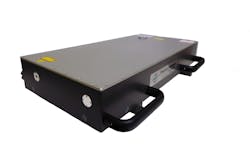Photonics Industries increases green DPSS laser rep rate to 40 MHz
Demand for solar-energy products is booming. To keep up, Photonics Industries’ Laser Focus World 2020 Innovators Award-winning SN Series subnanosecond laser technology increases the green diode-pumped solid-state (DPSS) laser’s operating repetition rate from single shot to 40 MHz, enabling faster manufacturing of passivated emitter and rear contact (PERC) solar cells.
PERC solar cells are modified conventional crystalline silicon cells, enabling 6–12% more energy conversion than conventional solar panels by collecting the additional light and electrons normally lost off the backside of a solar cell.
The manufacturing of PERC solar cells requires a high-rep-rate green laser with sufficient pulse energy. The green wavelength is used because it lessens the damage to the bulk solar material. Furthermore, the laser’s pulse width is important, and it has been found that subnanosecond pulse widths allow the best process window for the widest selection of PERC manufacturing recipes.
Other successful applications of the laser include sample preparation for microstructure diagnostics and failure analysis. Using the ultrashort pulses from the subnanosecond laser is found to be ideally suited for sample preparation. Micron-scale target precision, made possible due to the subnanosecond laser’s good TEM00 (i.e., M2 <1.3) mode, yields low structural damage. High-volume sample preparation is achievable due to the high rep rate/pulse energy combination of the subnanosecond laser for this microstructure diagnostics and failure analysis application.
Front-end production in semiconductor fabs is moving from 14 nm critical dimensions (CDs) down to 5–7 nm CDs. This has prompted the emergence of the need for EUV-based lithography and the associated quality/defect control wafer/chip inspection technologies to find and identify these smaller and smaller yield-limiting, performance-reducing “killer defects” created during semiconductor fabrication. Here, combinations of lasers are often required to generate the EUV light, but high-pulse-energy picosecond lasers are a key component. Pulses ~100 ps from the subnanosecond laser can support higher single pulse energies (i.e., up to 4 mJ/pulse) than conventional ~10 ps lasers can.
Similarly, satellite laser ranging (SLR) and 3D lidar benefit from these longer pulse width/higher single pulse energy picosecond pulses. Photon counting, 3D imaging, lidar, bathymetry, coastal zone mapping and imaging lidar, and cryosphere and biomass measurements all benefit from the laser's higher power (yielding higher altitudes/wider swaths) in combination with its shorter pulses (affording more measurement accuracy).
What was once described as “no man’s land” (i.e., lasers in the ~100 ps range) is now with the increase in average power available from Photonics Industries’ subnanosecond laser:
- Up to 200 W in the infrared
- >100 W in the green
- >50 W in the UV
Source: Photonics Industries press release – October 13, 2020
